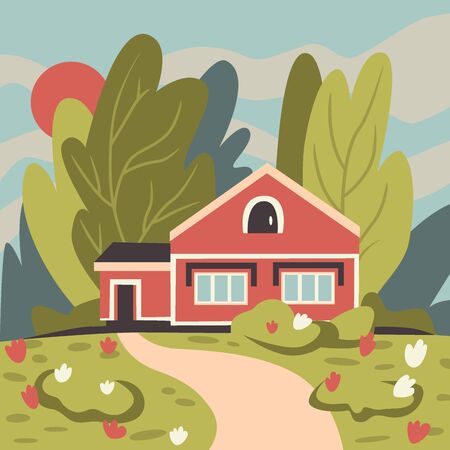1. Understanding Permaculture Principles
Permaculture is more than just a gardening method—its a way of designing your outdoor space to work with nature, not against it. At its core, permaculture is guided by three main ethics: Earth Care, People Care, and Fair Share. These values help homeowners make sustainable and environmentally friendly landscaping decisions that support local ecosystems.
Earth Care
This principle is about respecting and nurturing the natural world. In your backyard, this can mean planting native species that require less water and are naturally resistant to local pests. It also includes building healthy soil through composting and reducing synthetic chemical use.
People Care
Permaculture encourages us to design spaces that support human well-being. This could be as simple as creating a peaceful garden area for relaxation or growing fruits and vegetables to share with family and neighbors. It’s about making your yard not just beautiful, but also functional and supportive of your daily life.
Fair Share
Also known as “returning the surplus,” this ethic promotes sharing resources and giving back to the earth. This might involve distributing extra produce from your garden or creating habitat areas for pollinators like bees and butterflies.
Permaculture Ethics at a Glance
| Ethic | Description | Backyard Application |
|---|---|---|
| Earth Care | Protecting and regenerating natural systems | Use native plants, compost, reduce chemicals |
| People Care | Supporting health and community well-being | Create relaxing spaces, grow food, involve family |
| Fair Share | Sharing surplus and limiting overconsumption | Share produce, support pollinators, donate extras |
By understanding these principles, you can begin transforming your yard into a thriving ecosystem that benefits both people and the planet. Whether youre planting milkweed for monarch butterflies or setting up a rainwater collection system, every small step contributes to a more sustainable future.
2. The Role of Native Plants in a Sustainable Garden
Native plants play a powerful role in creating a sustainable, biodiverse backyard that works with nature instead of against it. These are the plants that have evolved over thousands of years to thrive in your local climate, soil, and ecosystem. When used in permaculture design, native plants help create self-sustaining gardens that require less water, fewer chemicals, and minimal maintenance.
Why Native Plants Matter
Native plants are vital for supporting local ecosystems. Because they co-evolved with native wildlife, they provide essential food and habitat for birds, butterflies, bees, and other pollinators. Unlike non-native species, which can sometimes disrupt natural balances or become invasive, native plants work in harmony with the environment.
Key Benefits of Using Native Plants
| Benefit | Description |
|---|---|
| Support for Pollinators | Native flowers bloom at the right times to feed bees, butterflies, and hummingbirds throughout the growing season. |
| Low Maintenance | Once established, native plants need less watering and fertilizing because they’re adapted to local conditions. |
| Pest Resistance | Their natural resilience means fewer pest issues and less need for chemical treatments. |
| Erosion Control | The deep root systems of many native species help prevent soil erosion and improve drainage. |
| Biodiversity Boost | A variety of native plants attracts a wider range of beneficial insects and animals to your garden. |
How Native Plants Support Wildlife
Your backyard can become a sanctuary for local wildlife simply by planting natives. For example, milkweed is critical for monarch butterflies to lay their eggs. Oak trees support hundreds of species of caterpillars that birds rely on to feed their young. By choosing a mix of native trees, shrubs, grasses, and perennials, you create layers of habitat that serve different needs—from nesting birds to ground-dwelling insects.
Create a Pollinator-Friendly Garden
If you want to attract pollinators like bees and butterflies, include a diverse mix of native flowering plants that bloom from early spring through fall. Avoid pesticides whenever possible—they can harm the very pollinators youre trying to support. Grouping the same plant species together in clusters makes it easier for pollinators to find them.
Pro Tip:
Add a shallow water source like a birdbath or small dish with stones so insects can land safely while drinking. This small addition can make your backyard even more welcoming to beneficial creatures.

3. Designing Your Backyard with Biodiversity in Mind
When designing your backyard using permaculture principles and native plants, the goal is to create a healthy, self-sustaining ecosystem that supports a wide variety of life. This means choosing the right plants, understanding how they interact, and structuring your garden in a way that encourages beneficial relationships between species. Here are some practical tips to get you started.
Companion Planting: Nature’s Teamwork
Companion planting involves placing plants together that benefit each other in some way—through pest control, improved growth, or better flavor. This method mimics natural ecosystems where different species support one another.
| Plant | Best Companions | Benefits |
|---|---|---|
| Tomatoes | Basil, Marigolds | Repels pests, improves flavor |
| Carrots | Onions, Chives | Deters carrot flies |
| Corn | Beans, Squash (Three Sisters) | Nitrogen fixing, ground cover, support |
| Lettuce | Radishes, Strawberries | Provides shade and pest protection |
Layered Planting: Maximizing Space Naturally
Layered planting is inspired by forest ecosystems where plants grow at different heights and occupy various layers of space—from tall canopy trees to low-growing ground covers. This technique helps maximize biodiversity and garden productivity.
The Seven Layers of a Permaculture Garden:
- Canopy Layer: Tall trees like oaks or fruit trees providing shade and shelter.
- Sub-Canopy Layer: Smaller trees such as dogwoods or serviceberries.
- Shrub Layer: Native shrubs like elderberry or blueberry bushes.
- Herbaceous Layer: Perennials like echinacea, yarrow, or milkweed.
- Ground Cover Layer: Creeping thyme or clover that retains moisture and prevents weeds.
- Rhizosphere (Root) Layer: Root vegetables like carrots or radishes.
- Vertical Layer: Vines such as native honeysuckle or beans growing on trellises.
Create Wildlife Corridors and Habitat Zones
A biodiverse yard welcomes more than just plants—it also invites birds, butterflies, bees, and beneficial insects. To make your garden wildlife-friendly, consider creating corridors and safe spaces for these creatures to thrive and move freely.
Tips for Supporting Local Wildlife:
- Add native flowering plants: Choose species that bloom at different times for continuous nectar sources.
- Create brush piles or log corners: These provide shelter for insects, amphibians, and small mammals.
- Avoid pesticides: Chemicals can harm pollinators and disrupt your garden’s balance.
- Add water sources: A birdbath or shallow dish with pebbles can help pollinators stay hydrated.
- Diversify plantings: Use a mix of grasses, flowers, shrubs, and trees to attract different species.
Your Biodiversity-Friendly Backyard Checklist:
- [ ] Use at least 3 types of companion plant pairings
- [ ] Incorporate 4 or more layers of planting structure
- [ ] Add at least one native shrub or tree per 100 sq ft of garden space
- [ ] Provide fresh water for birds and pollinators year-round
- [ ] Avoid synthetic pesticides or herbicides completely
- [ ] Leave some natural “mess” like leaf litter or old stems for habitat value
By following these simple guidelines and thinking about biodiversity from the start, you’ll be creating a thriving backyard ecosystem that supports both your plants and local wildlife. It’s not only good for the environment—it makes gardening more rewarding too!
4. Water Conservation and Soil Health
One of the key principles of permaculture is working with nature, not against it. When it comes to your backyard, this means making the most of natural resources like rainwater and building rich, living soil that supports native plants and local wildlife. Let’s explore some simple ways you can conserve water and improve soil health right in your own yard.
Rain Gardens and Swales: Smart Water Solutions
Rain gardens and swales are two effective permaculture techniques that help manage water naturally. They collect rainwater, slow it down, and allow it to soak into the ground instead of running off into the street or storm drains. This not only helps prevent erosion but also keeps your garden hydrated during dry spells.
| Technique | Description | Benefits |
|---|---|---|
| Rain Garden | A shallow, planted depression designed to capture runoff from roofs or driveways | Reduces runoff, filters pollutants, adds beauty to your landscape |
| Swale | A shallow ditch following the contour of the land to catch and spread water | Prevents erosion, hydrates surrounding soil, supports deep-rooted plants |
Building Healthy Soil with Composting and Mulching
Healthy soil is full of life—microbes, fungi, earthworms—all working together to support plant growth. You can create this kind of soil by using compost and mulch regularly.
Composting
Composting is an easy way to recycle kitchen scraps and yard waste into rich, dark humus that feeds your plants naturally. It also reduces landfill waste and helps retain moisture in the soil.
Mulching
Mulch is a layer of organic material like wood chips, straw, or shredded leaves placed over soil. It helps regulate temperature, suppress weeds, and keep moisture where it’s needed—at the roots of your plants.
Types of Organic Mulch:
- Bark or Wood Chips – Long-lasting and great for pathways or around trees
- Straw – Ideal for vegetable beds; breaks down quickly to enrich soil
- Shredded Leaves – Free and abundant in fall; good for flower beds and borders
By using these permaculture strategies—like installing rain gardens and swales or improving your soil with compost and mulch—you’re not just saving water. You’re building a thriving ecosystem in your backyard that supports native plants, attracts pollinators, and contributes to a healthier planet.
5. Creating Habitat and Encouraging Wildlife
One of the most rewarding aspects of using permaculture principles and native plants in your backyard is the opportunity to support local wildlife. By designing your garden to include food, water, shelter, and nesting spaces, you can turn your yard into a thriving habitat for birds, bees, butterflies, and even small mammals.
Why Wildlife Matters
Wildlife plays a crucial role in maintaining a healthy garden ecosystem. Birds help control pests, pollinators like bees and butterflies assist with plant reproduction, and other beneficial insects contribute to soil health and natural pest management.
Designing for Biodiversity
A diverse garden is a resilient one. Including a wide variety of native plants supports different species throughout the seasons. Layered planting—combining groundcovers, shrubs, trees, and vines—creates multiple levels of habitat that appeal to different kinds of animals.
Key Elements to Include:
| Element | Purpose | Examples |
|---|---|---|
| Diverse Native Plants | Provide food and shelter year-round | Milkweed (for monarchs), Coneflowers (for pollinators), Oak trees (host many insects) |
| Water Sources | Support birds, insects, and amphibians | Birdbaths, small ponds, shallow dishes with stones for bees |
| Nesting Sites | Encourage breeding and long-term visits | Birdhouses, brush piles, dead wood logs |
| Shelter Areas | Offer protection from predators and weather | Dense shrubs, rock piles, tall grasses |
Attracting Beneficial Insects
Not all bugs are bad! Ladybugs, lacewings, and parasitic wasps help keep aphids and other pests under control. Planting nectar-rich flowers like yarrow, goldenrod, and fennel can invite these helpful allies into your garden.
Create an Insect Hotel:
You can build or buy an insect hotel—a wooden structure filled with natural materials like bamboo tubes, straw, pinecones, and bark—to provide safe nesting spaces for solitary bees and other insects.
Welcoming Birds to Your Backyard
Birds are both entertaining to watch and incredibly useful in the garden. They eat insects, spread seeds, and add music to your outdoor space. Offer them food through native berry-producing plants like elderberry or serviceberry. Avoid pesticides so you don’t harm their food sources.
Tips for Attracting Birds:
- Add bird feeders with seeds suited to local species (e.g., sunflower seeds for finches)
- Install nesting boxes appropriate for your region’s native birds
- Provide clean water year-round with heated birdbaths in winter if needed
The Role of Shelter in Garden Ecology
Shelter doesnt just mean hiding spots—it also includes areas where animals feel safe enough to rest or raise young. Creating undisturbed corners with native grasses or letting part of your yard go wild can make a big difference for wildlife.
Remember:
Your backyard doesn’t have to be perfect—it just needs to be welcoming. Even small changes can make a big impact when it comes to supporting biodiversity right outside your door.


